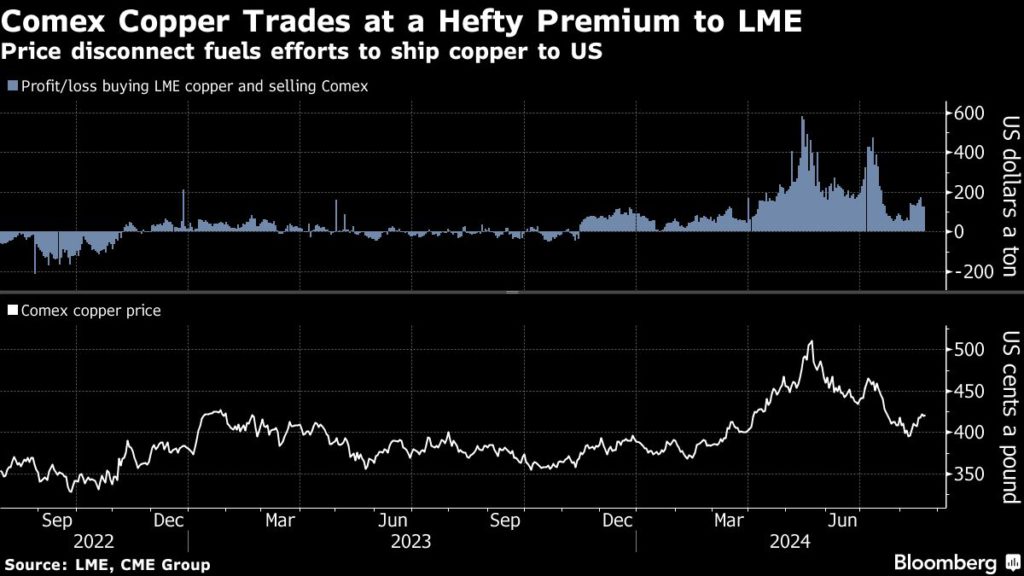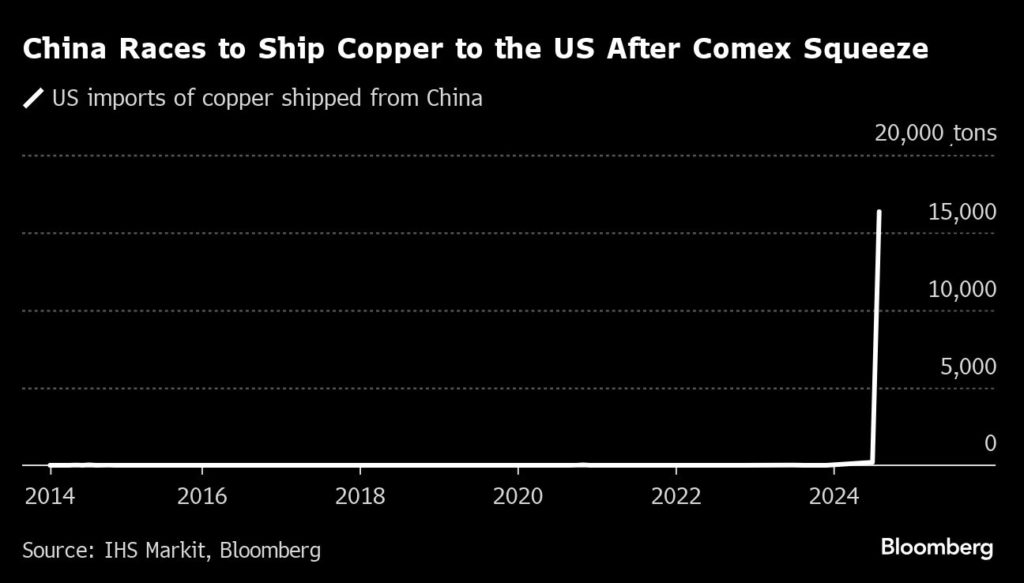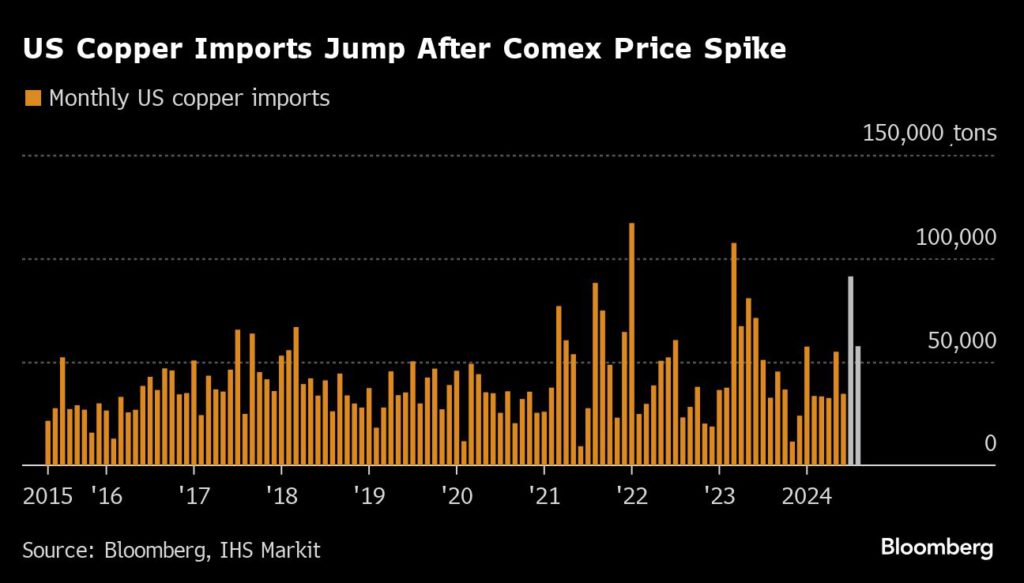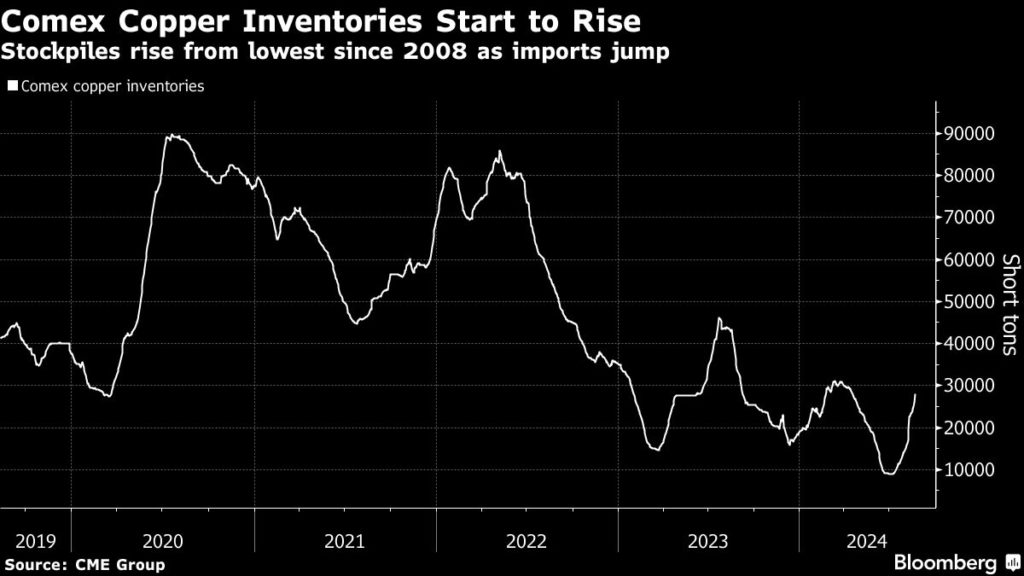
When copper surged toward a record high in New York in May, a ship was in the Pacific Ocean carrying a raw form of the metal from Chile to top buyer China.
By the time the Ricarda arrived in Shanghai in June, the global copper market had been upended by a short squeeze. It then received an unusual request: Reload with more copper in China — a country that typically needs to import vast volumes to meet its needs — and take it back to the US, where the metal was fetching unprecedented premiums as the market reeled from the squeeze.
The 15,000-ton Ricarda cargo that reached New Orleans in July highlights a seismic shift in the market this year that has led China to ship out record amounts of copper as a downturn leaves it with too much metal. At the same time, the US has experienced a flood of imports after the price spike on New York’s Comex exchange made it lucrative to send physical supplies there.
The huge dislocation between global prices saw the US import about 91,000 tons in July alone, the third-largest monthly amount in the last decade, shipping data from IHS Markit show. Most has come from Chilean mines run by Codelco, BHP Group and Antofagasta Plc.

The market distortions surprised major players from traders to money managers. China usually scoops up millions of tons of copper a year to feed its industries, but has been exporting large volumes due to subdued domestic consumption.
“It’s highly unusual that China would elect to export units,” said Duncan Hobbs, research director at trader Concord Resources Ltd. “It’s easy to understand why it happened given the price incentive, but those exports were only possible because people had surplus metal on hand when the opportunity arose.”
China’s economic malaise and its copper exports have spooked investors, pushing prices around the world down more than 15% from May peaks.
A key question is whether China’s export surge is drawing to a close, especially amid signs demand is starting to pick up again and with outbound shipments falling from highs. But people involved in shipments say more metal is on the way to the US and Asian ports outside China — with a final spurt of deliveries possible before flows return to normal.

The New York rally began as hedge funds piled into the market, betting on a demand boom at a time of low American stockpiles.
The chance to really cash in on a disjointed market appeared in May, when investors who had bet on the Comex contract moving back in line with London and Shanghai benchmarks were forced to buy those positions back as prices rose, creating a vicious cycle of pushing futures higher.
That enabled some traders to book big profits by shipping copper to Comex warehouses and using it to close out trades physically — sparking a rush to do so before the window closed — though only a handful of producers globally make the type of copper that can be delivered on the Comex.
While the squeeze on investors passed quickly, Comex copper stayed at sizable premiums to the London Metal Exchange and the Shanghai Futures Exchange until recently, so traders kept scouring for physical metal that can be used in so-called arbitrage trades.
Those efforts appear to be bearing fruit. The US imported almost 60,000 tons of copper so far this month, according to the latest IHS Markit data.

Tapping the arbitrage window can be tricky. No major Chinese smelters are registered with Comex, meaning their copper can’t be delivered on the exchange. But traders can either divert China-bound cargoes to the US, or ship eligible metal that has arrived from South America back across the Pacific.
China has been exporting to other Asian countries too, with inflows into warehouses in South Korea and Taiwan pushing overall LME copper stockpiles to the highest since 2019. Chinese inventories have also jumped. While Comex inventories rose in recent weeks, they remain comparatively tight.

Still, more big deliveries to the US would leave buyers there better supplied. Some traders say August imports could reach as much as 140,000 tons — which would be the biggest monthly inflow in at least a decade — and that September volumes could hit roughly 100,000 tons.
Other crucial questions are how much copper will actually end up on the Comex, and how prices will react.
Recent imports have helped lift the bourse’s inventories from the lowest since 2008, but traders say a lot of metal that has been arriving may be sold directly to manufacturers who pay additional premiums on top of Comex prices.
“It will give the market a bit of indigestion to take all of that volume right away, so I expect some will go to consumers, and some will end up on exchange,” Concord’s Hobbs said.
If a lack of demand from manufacturers inflates Comex stockpiles, and if that pressures prices, then Comex’s premium over the LME and SHFE could disappear entirely. It has already narrowed to such an extent that traders say booking new cargoes from China to the US no longer makes sense — but there could still be a final few vessels like the Ricarda already on their way.
(By Mark Burton)
Comments